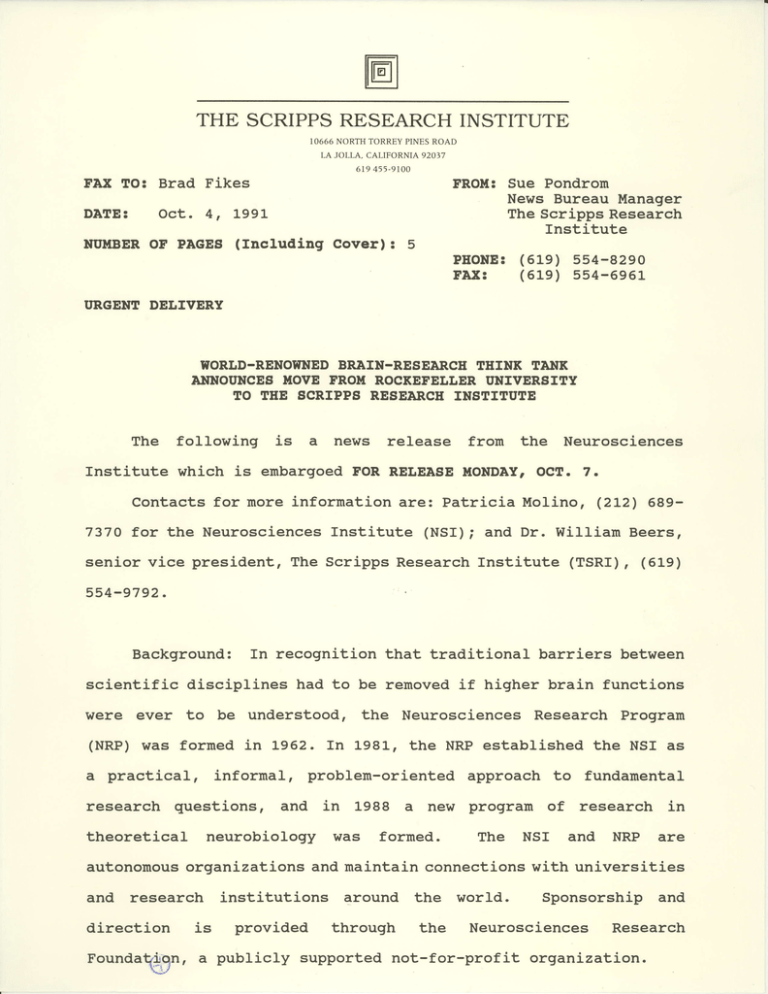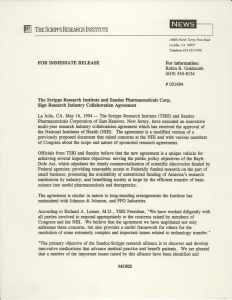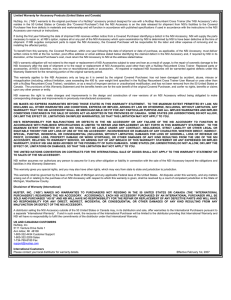THE SCRIPPS RESEARCH INSTITUTE
advertisement

THE SCRIPPS RESEARCH INSTITUTE
I0666 NORTH TORREY PINES ROAD
LA JOLLA. CALIFORNIA 92037
619 455-9tOO
FAX TO3 Brad
Fikes
Oct.
DATE 3
4,
FROI*I: Sue Pondrom
News Bureau Manager
The Scripps Research
Institute
1991
OF PAGES (Including
DII'}IBER
Cover):
5
PEONE: (519) ss4-8290
(519) 5s4-6961
FAX:
URGENT DEIJIVERY
WORI,D-RENOMIED BRAIN-RESEARCE TEINK TAT{K
AIINOT'NCEs IIOVE FROII ROCKEFELLER T'DIIVERSITY
TO rIIE SCRIPPS RESEARCU IIISTITUTE
The
Institute
which
Contacts
7370 for
senior
is
following
is
for
a
news
embargoed
president,
from
the
Neurosciences
FOR REITEASEltOlilDAY, OCT. 7.
more information
the Neurosciences
vice
release
are:
Patricia
(NSI);
Institute
The Scripps
(2L2) 589-
Molino,
and Dr. Witliam
Beers,
(TSRI),
Research Institute
(619)
554-9792
In recognition
Background:
scientific
disciplines
were
to
ever
be
(NRP) was formed
a practical,
research
understood,
the
L962.
1981,
in
questions,
and
neurobiology
institutions
research
provided
direction
is
Founda\$n,
a publicly
in
1988
was
the
a
and maintain
through
supported
brain
approach
connections
the
the
functions
NRP established
The
world.
to
NSI as
fundamental
of
NSI
Prograrn
the
research
and
with
NRP
in
are
universities
Sponsorship
Neurosciences
not-for-profit
between
Research
new program
formed.
around
higher
Neurosciences
problem-oriented
autonomous organizations
and
In
barriers
traditional
had to be removed if
informal,
theoretical
that
and
Research
organization.
The NeurosciencesInstitute
of the NeurosciencesResearchProgram
1230York Avenue
NewYork, N.Y 10021
n2570-8975
FOR RELEASE: MON., OCT.7
FOR INFORMATION:
Patricia Molino
Molino * Associates.Inc.
212-689-7370
NET]ROSCIENCES INSTITT]"TE PLANS MOVE
TO SCRIPPS CAMPUS
NEW YORK, N.Y., Oct. 7 -- The NeurosciencesInstitute (NSD, an independent
scientific center at the forefront of researchon the brain, plans to move from the
campusof The RockefellerUniversity in New York City to The ScrippsResearch
Institute (TSRD in La Jolla, California. TSRI is the largestprivate biomedical
researchinstitution in the countrv.
J
GeraldM. Edelman,M.D., Ph.D., director of the NSI, and RichardA.
Lerner, M.D., presidentof TSRI, announcedthat a new building will be constructed
especiallyfor the NSI on the TSRI campusbefore the current agreementwith The
Rockefeller University expiresin June, 1994.
"The new location will doublethe size of our current quartersand enhance
our opportunities to tap the growing scientific and financial resourcesof the Pacific
Rim," said Henry G. Walter, Jr., chairmanof the Board of the Neurosciences
ResearchFoundation,the NSI's parent organization. He added, "'We thank
Rockefeller University for its hospitality during our stay, and we look forward to
continuing relationshipswith Rockefellerand with the Massachusetts
Institute of
Technology, our prior host institution."
Understanding the brain through cooperative studies
sporuored by the
NeurosciencesResearchFoundation
Institute-- 2
Neurosciences
"We're honoredthat the prestigiousNeurosciencesInstitute should choose
to relocateat The ScrippsResearchInstitute,"said CharlesC. Edwards,M.D.,
presidentand chief executiveofficer of ScrippsInstitutionsof Medicine and Science,
the parent organizationof TSRI. "Not only will this move complement and broaden
our scientific investigations,it representsa major acquisitionfor the West Coast."
Dr. Lerner noted that "this is an extraordinaryopportunity for TSRI. The
move will strengthenboth institutions."
The NeurosciencesInstitute was formed to foster understandingof how the
brain functions and to promote the developmentof theories that could spur brain
research. As befits the most complex of objects(the brain has 50 billion cells and a
million billion connectionsbetweenthem), the NSI aims to understandthe brain at
many levels, from the molecular -- how chemicalinteractionsaffectsneurons-- to
the behavioral -- how we learn or remember.
Dr. Edelmatr,a Nobel Laureatein Medicine in 1972, explainsthe NSI's
mission this way: "The vast technicaladvancesand experimentaldiscoveriesof the
past two decadeshave createda unique opportunityfor major progressin
understandingthe brain. But theoriesto integratethis information are needed."
He noted that the specific aim of the NSI's researchprogram is to develop
biologically-basedtheoriesof the brain becausethese "are more likely to explain
brain functions than are theoriesderived from non-biologicalfields, such as
computer sciences,neural nets or artificial intelligence."
Neurosciences
Institute-- 3
Much of the researchat the NSI is basedon Dr. Edelman'stheory, which
is called "neural Darwinism" or "neuronalgroup selection." One implication of this
theory is that every experiencewe have shapesand alters our brain in unique ways.
These changesthen affect how we respondto future experiences. The theory
attemptsto take into account what has been learned about the structure and function
of the brain from a broad affay of disciplines,including neurophysiology,
psychology, developmentalbiology and evolutionarystudies.
Computer simulationsthat are basedon Dr. Edelman'stheory are now
being designedand testedat the NSI. The simulations,carried out on NSI's
supercomputers,take the form of "creatures"or automatathat learn from experience
to categorizeobjects, respondto novelty in their environment,and even react in
unpredictableways. Practicalapplicationsof thesedevelopmentspromise to result in
revolutionary new usesof computers.
NSI scientistsare also developingand testingtheoriesabout touch, vision
and other brain functions, as well as abouthow connectionsin the brain are
strengthenedor weakened. This work can be appliedto improve the diagnosisand
treatmentof nervous systemdisorders,especiallythoseconcerningmemory.
In addition to its major researchactivitiesin theoreticalneurobiology, the
NSI hostsvisits by researchscholarswho use the time to plan experiments,write
comprehensivereviews of current research,hold intensiveresearchworkshopsor
study allied disciplinesfor new insights. Sinceits founding, more than 850 scientists
from 24 cotntries have participatedin the NSI's programs.
Institute- 4
Neurosciences
Program,an international
Reaearch
The NSI is alsothe homeof the Nzurusciences
in 1962at the
eloctedcollegeof 36 leadingscientists,whiehwase$tablished
InstitutEof Technotogyto prcnote theinterdiserplinarystudyof the
Massachusetts
brain. The Programmovedto The RockeftllerUniversitycampusin 1982whenthe
NSI wasfoundedthere.
Dr. Edelmanwill moveto TSRI to headthe newly-createdDepartmentof
Neurobiology,which is indElendentof the NSI. He wi{ beJoinedin that department
Ph.D.
by his colleagueat The RockefellerUniversity,BnrceA. Cunninghaur,
The ScrippsReseatchInstltuteie intornationallyrecognizedfor its basic
biomedicalresearchin struchrralandmolesulf,rbiology, chemistryandimmunology.
TSRI's innovativecross-disciplinary
approachto manyscientificproblemshas
is
attracteda numberof notedresearchers.A strongprogfamin nzuropharmacology
headedby Floyd Bloom,M,D.n a prominentneffosciensstknownfor his work on
andbehavioralregulation. In addition,a new Celt Biology
neuropeptides
in luly andsiaffedby cell biologise recognizedfor their
Departmentwas established
work in determiningthe stnrchrre.function
relationshipsof biologicallyimporant
molecules.The new Departmentof NErrrobiolry inidativeis expectedto broadert
andextendtheseinterdieciplinaryresearcharorizorls.






